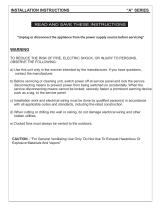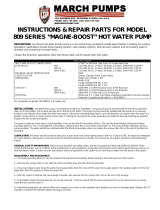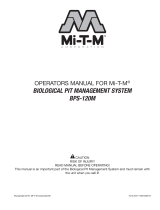
English (GB)
14
8. Servicing the product
The life of the product depends largely on the
operating conditions, so we strongly recommend
daily inspection and periodic servicing in order to
guarantee maximum product lifetime.
8.1 Safety instructions and requirements
8.2 Service documentation
Service documentation is available on
www.grundfos.com > International website >
Grundfos Product Center > Service & support.
If you have any questions, please contact the
nearest Grundfos company or service centre.
8.3 Contaminated products
The product will be classified as contaminated if it
has been used for a liquid which is injurious to health
or toxic.
If you request Grundfos to service the product,
contact Grundfos with details about the pumped
liquid before returning the product for service.
Otherwise, Grundfos can refuse to accept the
product for service.
Any application for service must include details
about the pumped liquid.
Clean the product in the best possible way before
you return it.
Costs of returning the product are to be paid by the
customer.
8.4 Maintenance
Under normal operating conditions, remove the
pump from the pit and inspect it once every year.
Under severe operating conditions where sand,
fibrous material and solids are involved, do this once
a month.
Check the following points:
• Electrical test of the motor
See sections 8.4.1 Checking the current and
voltage and 8.4.2 Checking the insulation
resistance.
• Outlet pressure and flow rate
See section 8.4.3 Checking the outlet pressure
and flow rate.
• Seal-sensor resistance
See section 8.4.4 Inspecting the seal sensor.
• Oil level and oil condition
See section 8.4.5 Oil check and oil change.
• Impeller clearance
See section 8.4.6 Inspection and adjustment of
impeller clearance.
8.4.1 Checking the current and voltage
Check the pump current and voltage. If the ammeter
reading exceeds the rated value or is far lower than
the rated value, there is a problem. The voltage must
be stable within - 5 %/+ 5 % of the rated value
throughout the operational period.
8.4.2 Checking the insulation resistance
If the insulation resistance has declined sharply
since the previous reading, this is an indication of
impending insulation failure, and the pump must be
scheduled for service even though the insulation
resistance may still be over 10 mega ohms.
8.4.3 Checking the outlet pressure and flow rate
Declining performance can indicate the need for an
overhaul. Regardless of performance, the pressure
and flow rate must be stable, and rapidly changing
pressure or flow rate indicate system problems on
the inlet or outlet side.
WARNING
Electric shock
Death or serious personal injury
- Before starting any work on the product,
make sure that the fuses have been
removed or the main switch has been
switched off and locked in position 0.
Make sure the power supply cannot be
accidentally switched on.
WARNING
Crushing of hands
Death or serious personal injury
- Make sure that all rotating parts have
stopped moving.
Maintenance and service must be carried
out by specially trained persons.
WARNING
Biological hazard
Death or serious personal injury
- Flush the product thoroughly with clean
water and rinse the product parts in
water after dismantling.
The insulation resistance of the motor
must be measured at least once a month.
The outlet pressure and flow rate must be
measured at least once a month if a
flowmeter is available.























